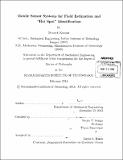| dc.contributor.advisor | Sanjay E. Sarma. | en_US |
| dc.contributor.author | Kumar, Sumeet, Ph. D. Massachusetts Institute of Technology | en_US |
| dc.contributor.other | Massachusetts Institute of Technology. Department of Mechanical Engineering. | en_US |
| dc.date.accessioned | 2014-06-13T22:38:52Z | |
| dc.date.available | 2014-06-13T22:38:52Z | |
| dc.date.copyright | 2014 | en_US |
| dc.date.issued | 2014 | en_US |
| dc.identifier.uri | http://hdl.handle.net/1721.1/87977 | |
| dc.description | Thesis: Ph. D., Massachusetts Institute of Technology, Department of Mechanical Engineering, 2014. | en_US |
| dc.description | Cataloged from PDF version of thesis. | en_US |
| dc.description | Includes bibliographical references (pages 155-166). | en_US |
| dc.description.abstract | Robust, low-cost mobile sensing enables effective monitoring and management of urban environment and infrastructure which contributes towards a sustainable future. While mobile sensor systems have attracted significant attention in recent years, a large scale deployment for urban infrastructure monitoring poses many research challenges. One fundamental challenge is dealing with noisy and uncontrolled samples stemming from both noisy sensor measurements and locations, and lack of control on sensor deployment. Such conditions pose difficulties in field estimation and "hot spot" identification from sensor data. My thesis contributions aim to bridge this gap. In this thesis, I designed and developed a mobile sensor system for urban light infrastructure monitoring and studied two problems on field estimation in the presence of noisy and uncontrolled samples with general implications on mobile sensing. As an example system, I designed and successfully tested a city-wide street light scanning mobile sensor platform. Currently, street light maintenance uses labor-intensive, poorly scalable manual inspection techniques. My system automatically maps street illumination levels and lamp infrastructure. The collected data presents challenges in identifying lamp "hot spots" from false positives and using sensor data from noisy sensor locations for estimating luminosity maps. I present an algorithm for identifying various light sources from video streams and combining that data with location information to geotag lamps. To identity the light sources, I developed a supervised classifier for lamp classification and later extended it to develop a method for estimating the height of the street lamps. As accurate car location information is critical for successful luminosity mapping, I discuss how I improved car location estimates by integrating multiple independent data streams such as vehicle speed data obtained via on-board diagnostic systems and GPS. Towards such field deployments, one must address fundamental challenges related to both hardware implementation and data analytics. In this thesis, I addressed two problems related to mobile sensor based sampling and signal estimation: nonuniform sampling and errors in sample location. Uniform grid sampling is often impractical in the context of mobile spatial sampling. As an alternative, I studied [delta]-dense sensor arrangements as a realistic scheme for non-uniform flexible sampling. To assess its utility, I derived sufficient conditions for estimating a signal represented in a finite-dimensional basis set and present simulation results on the numerical stability of signal estimation under [delta]-dense sampling. Furthermore, I present the use of proper orthogonal decomposition as a technique to obtain basis sets for signals that are solutions to a parametric differential equation. Finally, I studied how errors in the location measurements of mobile nodes affect the overall signal estimation problem. To address such signal estimation problems, I developed a computationally efficient iterative linear estimator and compared my approach to the state of the art expectation-maximization technique. I present simulation studies on the performance of the estimator and discuss results on its numerical stability. My approach offers several orders of magnitude reduction in computational time while achieving comparable mean squared estimation error to other techniques making it an appealing candidate for real-time embedded mobile sensing applications. | en_US |
| dc.description.statementofresponsibility | by Sumeet Kumar. | en_US |
| dc.format.extent | 166 pages | en_US |
| dc.language.iso | eng | en_US |
| dc.publisher | Massachusetts Institute of Technology | en_US |
| dc.rights | M.I.T. theses are protected by copyright. They may be viewed from this source for any purpose, but reproduction or distribution in any format is prohibited without written permission. See provided URL for inquiries about permission. | en_US |
| dc.rights.uri | http://dspace.mit.edu/handle/1721.1/7582 | en_US |
| dc.subject | Mechanical Engineering. | en_US |
| dc.title | Mobile sensor systems for field estimation and "hot spot" identification | en_US |
| dc.type | Thesis | en_US |
| dc.description.degree | Ph. D. | en_US |
| dc.contributor.department | Massachusetts Institute of Technology. Department of Mechanical Engineering | |
| dc.identifier.oclc | 880701097 | en_US |
